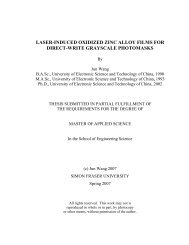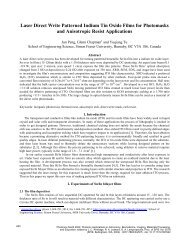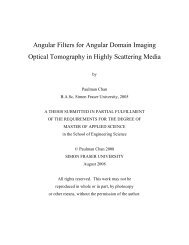Adding Grayscale Layer to Chrome Photomasks - Professor Glenn ...
Adding Grayscale Layer to Chrome Photomasks - Professor Glenn ...
Adding Grayscale Layer to Chrome Photomasks - Professor Glenn ...
Create successful ePaper yourself
Turn your PDF publications into a flip-book with our unique Google optimized e-Paper software.
Figure 21. Illustration of UV pho<strong>to</strong>lithographic exposure processes for SU-8 pho<strong>to</strong>resist and their resulting<br />
3D structures. (a) Exposure from SU-8 side. (b) Inverted 3D structure. (c) Exposure from substrate side.<br />
(d) Typical 3D structure.<br />
Using the combined bimetallic-chrome pho<strong>to</strong>mask, SU-8 is exposed in a mask aligner with the substrate side in<br />
contact with the protected chrome of our grayscale mask, as shown in Figure 21(c). The exposure dose for the mask<br />
aligner is 1 min at 12 mJ. Upon exposure, pho<strong>to</strong>acid is produced in the SU-8 which promotes initial cross-linking in the<br />
polymer. A post-exposure bake process is then performed immediately afterwards <strong>to</strong> further maximize the cross-linking.<br />
Using the hotplate, the post-bake procedure is the same as that for the pre-exposure bake, but in this case, the film does<br />
not sit overnight after cooling. Development is performed immediately after the exposed film has cooled <strong>to</strong> room<br />
temperature. With the cross-linking in the exposed region completed, the unexposed sections are removed by placing<br />
the patterned SU-8 film in<strong>to</strong> a SU-8 developer and agitated for 2 min. Regions in the SU-8 that are highly cross-linked<br />
will have a very slow development rate and will not be removed. After development, the film is blown dry with nitrogen<br />
gas without rinsing and a thermally stable, very transparent region remains.<br />
<strong>Grayscale</strong><br />
<strong>Grayscale</strong><br />
Figure 22. Backlight Bi/In/Cr mask with binary pattern<br />
superimposed on grayscale pattern.<br />
Figure 23. A SEM image of 3D structures created from<br />
the pho<strong>to</strong>mask pattern shown in Figure 22.<br />
The Bi/In grayscale pattern superimposed on a binary chrome pattern layer is shown in Figure 22. Because the<br />
chrome pattern is dark-field, the binary pattern appears brighter than the surrounding grayscale pattern. The<br />
corresponding 3D structures created from the mask pattern in Figure 22 are shown in Figure 23. A slope created from a<br />
continuous horizontal grayscale variation can be seen <strong>to</strong> be interspersed with rectangular structures created from the<br />
binary pattern in the chrome mask layer. The developed film thickness measures about 60 µm and the size of the<br />
squares on the slope is about 50 µm in width. Note also the sharp edges of the chrome defined openings, including the










